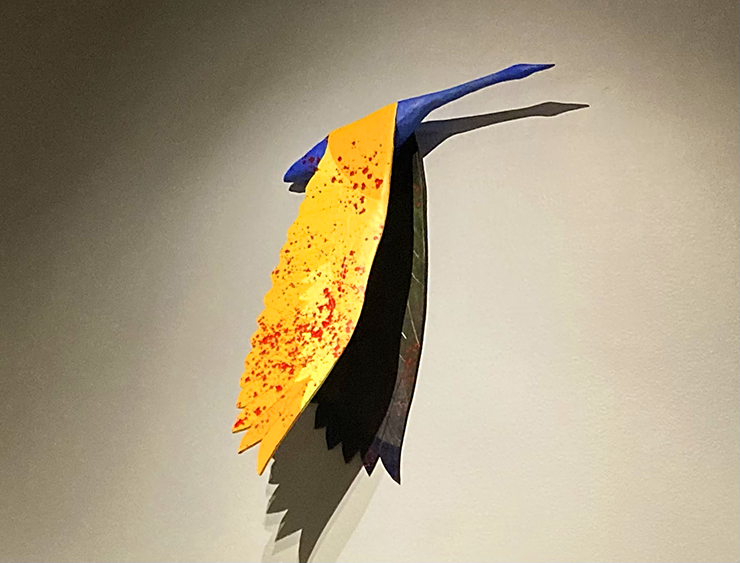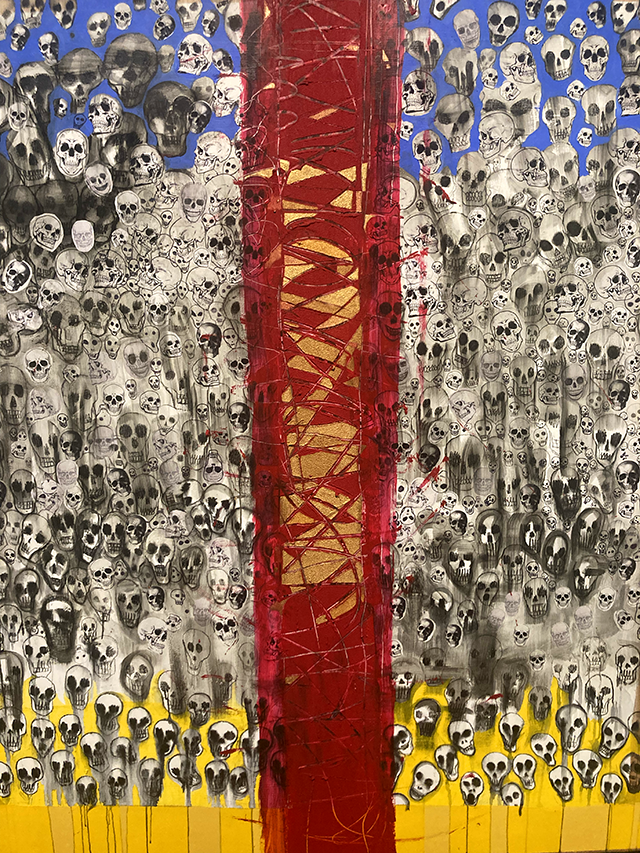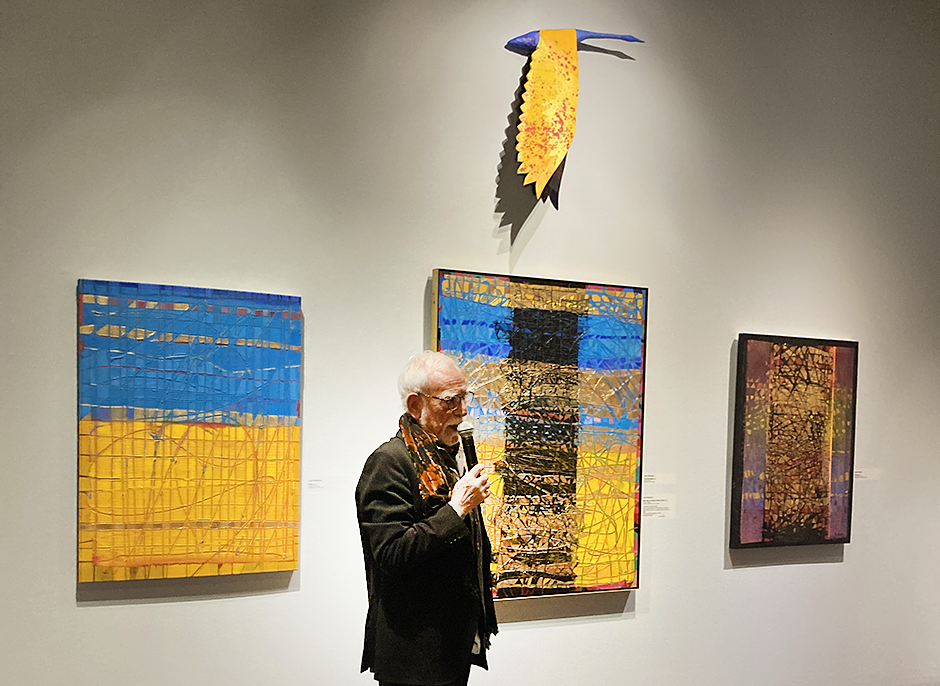Soaring high above Leon Hushcha’s other artworks at The Museum of Russian Art is a thin purplish blue bird with giant yellow-orange wings. The wings are splattered with red, like blood, and hang low, as if broken.
Hushcha first made the sculpture about 14 or 15 years ago. It was originally white, and he added red to indicate his distaste for war. After Russia’s invasion of Ukraine, Hushcha turned his attention once again to sculpture. “Because of the current war, I took it out and re-painted it white and started over again with the colors of the flag,” he tells a crowd of people on Saturday, when Hushcha’s exhibition, “The Way,” opened at TMORA along with Olga Volchkova’s “Nature’s Saints: Icons.”
“Because Ukraine is wounded, and has been wounded for centuries, but people don’t know that. This is just another example of Russia being aggressive.”
Hushcha calls it a wounded bird. “The Wounded” (2023) is its title. “It’s for the Ukrainian people,” he tells me in an interview. “I’ve never been in Ukraine, but I’m really Ukrainian.”
Hushcha’s parents immigrated to the U.S. from Ukraine in 1949. This was after his father spent 11 years in a gulag. After his imprisonment, Hushcha’s father met his mother, and they escaped. Hushcha, who was born in a displaced person’s camp in Austria, grew up in an impoverished neighborhood in St. Paul. He lived with his parents, his brother and his grandfather in a one-room apartment.

[image_credit]MinnPost photo by Sheila Regan[/image_credit][image_caption]“The Wounded,” (2022), Leon Hushcha[/image_caption]
The young refugee boy that Hushcha used to be appears in three portraits in the exhibition. One is based on a photograph, and the other two are drawn from memory. In one of the portraits, Hushcha paints a pigeon that abided in their home when he was a child.
“When I was sick, my mother would tell people, the pigeon laid with me and put her wing over my chest until I was well,” he says. His brother later told him Hushcha would lie with that pigeon every night.
Speaking at the museum last Saturday, Huschcha expresses being unable to stay away from political themes. “I can’t help myself because of what’s going on in the world,” Hushcha tells the crowd.
TMORA itself as an institution has publicly denounced Russia over the Ukraine invasion, posting statements of support for Ukraine on its website and social media pages, and even painting the side of its building yellow and blue. It also considered changing its name after pressure from the local Ukrainian-American community, but ultimately kept its Russian moniker. “The reason was, because 95 percent of what they own is Russian,” Hushcha tells me. “They couldn’t escape that part of it.”
Below Hushcha’s “The Wounded,” hangs another painting called “Blue Sky on Golden Wheat Fields.”

[image_credit]MinnPost photo by Sheila Regan[/image_credit][image_caption]“Blue Sky on Golden Wheat Fields” (2023), Leon Hushcha[/image_caption]
Speaking to the crowd on Saturday, Hushcha says, “This one’s dismantling the flag and putting it back together in a way that I feel has power and a different type of strength than the regular fight by itself.”
The painting is textured with a graphic pattern Hushcha says comes from being raised in the Eastern Ukrainian Orthodox Church. “When I was four or five years old, I was standing there with the incense going through me and looking at a lot of shiny things — a lot of gold, a lot of metal,” he says. In recent years, he’s made the connection that his graphic treatment of his paintings may have come from those memories from childhood.
Another painting is populated with hundreds of skulls — both painted and cut and pasted from the internet. It’s another expression of Hushcha’s distress over the war between Russia and Ukraine. “I’ve had trouble with the war,” he says. “I fell apart when the war started. I literally began to weep and cry. I couldn’t believe it.”
While the most recent conflict began with the Russian invasion of Ukraine, his understanding of the war goes back much further.
“I’ve been raised with this war since I was a child,” Hushcha tells me. “By the time I was five years old, I understood that the Russians wanted to get rid of the Ukrainians.”
The skull painting, “River of Red” (2023), comes from a vision Hushcha had one day as he was walking down the street. The next day, he told his assistant, Carley Novak, “We’re going to do skeletons,” he tells me. The skull piece also features Ukraine’s flag colors, and a deep red stripe, adorned with gold, slashing through the center.

[image_credit]MinnPost photo by Sheila Regan[/image_credit][image_caption]“River of Red,” (2023), Leon Hushcha[/image_caption]
It’s a happier painting, with glittery scribbles, fantastical beasts and Hushcha’s signature ornate, colorful border. There’s also a trident, placed almost surreptitiously near the corner, referencing Ukraine’s coat of arms.
Hushcha tells me the idea for including the trident, similar to the one worn by Ukrainian president Volodymyr Zelenskyy, came to him years ago, when he had a visit from an old Russian painter at his studio. Hushcha had a painting at the time he describes as “joyful.”
“(The painter) said, ‘This is really a joyful painting. Could you put in the Trident somewhere in secret, so they wouldn’t see it?’” Huschcha recalls. Years later, he’s taken the old Russian painter’s advice.
Not all of Hushcha’s works in “The Way” are specifically about Ukraine. His paintings and sculptures explore mysticism, love, imagination and dreams as well. Working intuitively, he often doesn’t know what he’s painting before he begins the work.
There are collaborations as well, including two paintings made with Ta-Coumba T. Aiken, highlighting the expressive colors and symbolic tendencies of each artist.
But as a whole, the exhibition speaks to the continued plight of the Ukrainian people. It’s as if the refugee-born artist is laying bare his heart with his brush.
Hushcha’s work is seen on the second floor of the museum. If you go, you’ll be treated to the museum’s holiday-themed exhibition, “The Wintertime Carnival,” featuring masks and decorations from the Romanov dynasty and the Soviet era on the first floor. Also on view in the museum’s back room on the first floor are paintings by Russian artist Olga Volchkova. Volchkova puts a new spin on the traditional style of Eastern Orthodox icon-painting. Made popular during the era of the Byzantine Empire, the sacred portraits are works of devotion to Christian figures, including Jesus, Mary, the saints and the angels. In Volchkova’s icons, rather than religious figures, she personifies garden plants, wild herbs, agriculture products and more, anointing them saints and visualizing them with rich narrative and symbolic detail. Richly layered with exquisite detail, Volchkova pays homage to even the deadliest plants with humble reverence.
“The Art of Leon Hushcha: The Way” is on view through March 3, “Nature’s Saints: Icons by Olga Volchkova” is on view through March 24, and “The Wintertime Carnival: Traditions of Old” is on view through Jan. 24, all in 2024. In the basement of the museum, you can see works from TMORA’s permanent collection as well as its anti-war political cartoon series by Ukrainian and Russian artists ($14 museum admission.) More information here.






